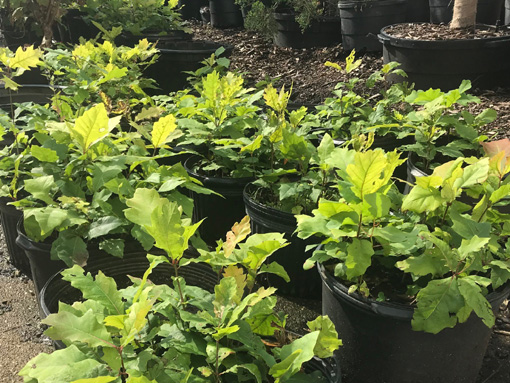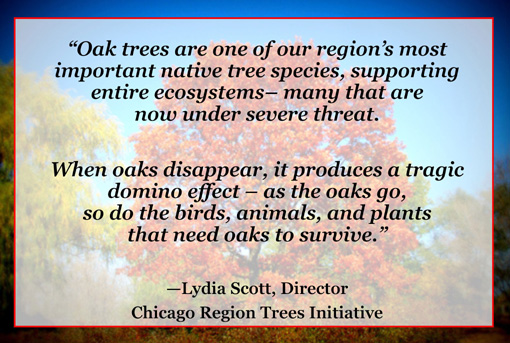In the 1880s, native oak trees comprised more than 60 percent of the Chicago region’s tree canopy. Today, that number has dwindled to only 5 percent. Sadly, oak trees are not only struggling in Illinois, but worldwide. About one-third of the world’s oaks are threatened with extinction, due to population growth, climate change and invasive species.
In October of 2015, Governor Bruce Rauner first proclaimed the month of October Oak Awareness Month, to highlight this crucial tree species that is in decline. This month, the Chicago Region Trees Initiative (CRTI), a coalition of environmentally-focused area organizations across seven counties in Illinois, raises awareness of this beautiful, endangered tree with its OAK-tober campaign.
The Importance and Benefits of Oaks
Oak trees are a keystone species, meaning they are trees that entire ecosystems depend on for survival and habitat. According to CRTI, oak acorns provide food for more than 100 vertebrate species of wildlife, and an oak tree’s massive trunk and branches provide shelter for many birds and mammal species.
Doug Tallamy, professor of entomology at Delaware University and author of the groundbreaking gardening book Bringing Nature Home, noted that over 500 species of Lepidoptera caterpillars (butterflies and moths) are supported by native oaks— more than any other tree species. Insects play a crucial role in the food web, acting as a food source for birds and their young, as well as many other species of animals.
Oak trees are beautiful. Most oaks turn a red, reddish brown, or yellow brown color in fall. White Oak and Pin Oaks turn red. Red Oak turns yellow brown. They have a sturdy, stately habit for winter interest.
They are long-lived. A three-hundred year old White Oak named The Millennium Landmark Tree can be found at the Morton Arboretum in Lisle.
The shade an oak tree canopy lowers outdoor temperature in summer and lowers utility bills.
A 25-inch diameter oak tree can intercept 3,492 gallons of stormwater per year, reducing storm runoff, according to CRTI.
If sited in a sunny area, there is an oak for almost every soil type. Bur Oak is tolerant of alkaline soils. Pin Oak tolerates moist soil. Swamp White Oak can handle occasional standing water. White Oak tolerates moist to dry soil. Not all oaks are slow-growing. Red Oak and White Oak will grow about a foot a year. Trees of several inches in caliper, several feet tall, can also be purchased.

Our President/CEO Tom Klitzkie gathered acorns last year, stored them in his refrigerator to prepare them, and potted them up. We now have over 100 saplings in our nursery that will be ready to plant in a few years.
What You Can Do
- Attend an OAK-tober event this month with family and friends. Events are listed on this page of the Chicago Region Trees Initiative website.
- Collect acorns and plant them in pots.Raise them for a few years so they can be planted into the community or a park.
- If you have an oak tree on your property, ensure it receives enough water. Protect its roots with an adequately mulched tree ring. Enlist the help of an arborist to check its health periodically.
- Plant an oak tree in your yard.

